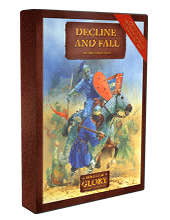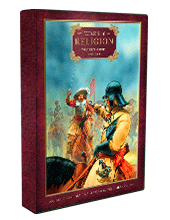Decline & Fall
This book covers the armies of the Byzantine Empire, the Islamic states and their other enemies, from 493 AD until the mid 11th century.
In 300 AD the Roman Emperor Constantine the Great founded Nova Roma (New Rome) on the site of the existing Greek city of Byzantion. It was to be the new capital of the Roman Empire. After his death it was renamed Konstantinoúpolis (Constantinople).
The last West Roman Emperor, Romulus Augustulus, was deposed by the federate Odoacer in 476. Odoacer was defeated and replaced by the Ostrogoths in 493. The East Roman Empire persisted. Historians usually call it the Byzantine Empire. As far as its mainly Greek-speaking inhabitants and their contemporary neighbours were concerned, however, it was still the Roman Empire. It lasted until Constantinople fell to the Ottoman Turks in 1453.
From 533 to 561, in the reign of the Emperor Justinian I, Byzantine (East Roman) armies reconquered North Africa from the Vandals, Italy from the Ostrogoths and Southern Spain from the Visigoths. This was to be the high water mark of the Byzantine Empire.
From 602 to 618, the eastern provinces of the Empire, including Mesopotamia, Syria, Palestine and Egypt, were conquered by the Sassanid Persians, and in 626 Constantinople was besieged by the Avars and their Persian allies. Constantinople held out. By attacking the Persians in their heartland, the Emperor Herakleios won the war and regained the lost Eastern provinces. However, large areas of the Empire’s European provinces were now occupied by Slavs. More territory south of the Danube was lost to the Bulgars in 679. The Bulgars subsequently conquered many of the former Byzantine territories held by Slavs and these areas were not reconquered by the Byzantines until the turn of the 10th/11thcenturies.
In 633, the Arabs, newly united under Islam by Mohammed, erupted from the Arabian peninsula to attack the Byzantines and the Persians, who were both exhausted by their recent war. By 646 the Arabs had conquered Syria, Palestine, Egypt and Mesopotamia from the Byzantines, and by 651 they had conquered most of the Sassanid Persian Empire. Constantinople was besieged unsuccessfully in 674. By 698 the Arabs had conquered most of the Byzantine provinces in North Africa. From 711 to 718 the Visigothic Kingdom in modern Spain was conquered. Constantinople was besieged again from 717 to 718, but once again held out. Further conquests were also made in Central Asia and India, so that by 718 the Umayyad Caliphate ruled a huge Empire stretching from Spain to India.
In 749 rebellion broke out and the Umayyad dynasty was deposed and replaced by the Abbasid dynasty, except in Spain where the Umayyads survived as an independent emirate. Central control declined, however. In 789, the Idrisids formed their own rival Shiite caliphate in Morocco. The Aghlabids in Tunisia achieved de facto independence by about 820. In the east also, semi- or de-facto independent dynasties arose, the Tahirids in 821, Saffarids in 861 and Samanids in 875. Eqypt became independent under the Tulunids in 868, but was reoccupied by Abbasid troops in 905. From 935 Egypt was held by the Ikhshidid dynasty before being conquered in 969 by the Fatimids from Tunisia. From 946 the Abbasid Caliph became a figurehead only, the remaining territories of the Abbasids (in modern Iraq), including the capital Baghdad, being ruled by the Dailami Buwayhids.
In the middle of the 11th century the Seljuk Turks erupted on the scene, conquering the Ghaznavids (in modern Afghanistan and Central Asia) and the Buwayhids before attacking the Byzantine Empire. In 1071 they decisively defeated the Byzantines at Manzikert, following which the Byzantines lost most of Asia Minor (modern Turkey). By the end of our period the Byzantine Empire was largely reduced to its European territories, the Seljuk Turks ruled from the Aegean to the borders of India, and the Fatimids in Egypt. North-West Africa and Spain were held by various independent emirates, though the Christian reconquest of the peninsula was well begun.
Early Byzantine
Later Moorish
Later Visigothic
African Vandal
Italian Ostrogothic
Early South Slav
Lombard
Maurikian Byzantine
Christian Nubian
Avar
Western Turkish
Arab Conquest
Early Bulgar
Thematic Byzantine
Umayyad Arab
Abbasid Arab
Early North African Dynasties
Khurasanian Dynasties
Bedouin Dynasties
Dailami Dynasties
Pecheneg
Ghaznavid
Nikephorian Byzantine



 Cart (0)
Cart (0)
